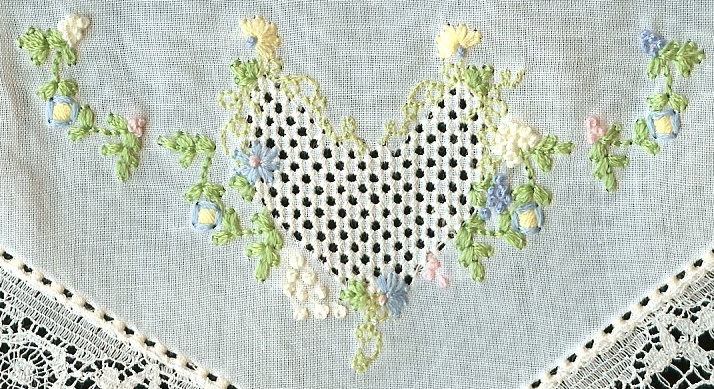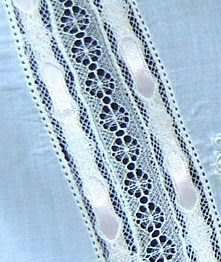Two year-old Alastair is here for a few days. I’m busy making sure the little guy does not fall in the pool or get himself into the dangerous trouble that toddlers are likely to find. But last night, after he was asleep, the mindless task of  pulling threads for the puffing strip fancyband on Laurel’s Easer dress allowed me the rare luxury of contemplation.
Of course, I thought about Laurel and the joy she has given me.  I thought about sewing and all the joy it has given me for the 31 years since I fell in love with heirloom sewing. I thought about all the dear friends I have made and all the wonderful people I have met, and all the joy they have given me.   I thought about all I have learned and all of the fine ladies who taught me and what joy this knowledge has given me.
Sewing is all about sharing–sharing your knowledge, sharing your projects as gifts, sharing your sewing supplies with others. I have been blessed beyond my merit on all counts.
Tonight, I thought I would share some of the most useful sewing tips I have learned through the years from women I will never forget. It would be sad to think I could include all I have learned in one post. So I’ve limited myself to only those techniques used on this dress!

The blue floss is has been repeated in French knots, lazy daisy flowers and the surround of the pinwheel roses.
embroidery colors–At one of our weekly luncheon dates, Suzanne Sawko once said that to her eye, too many colors made an embroidery look cluttered. She prefers to use only as many as is necessary for the integrity of the design. I hadn’t really thought about it in that light, as often I tried to emulate nature’s unlimited palette. With at least 42 shades of green embroidery thread at hand, I was tempted to use them all or at least many, in order to emulate nature’s palette.  Of course, shading is desirable and pleasing to the eye. But I reuse colors when possible and avoid a riot of color in embroidery designs. 
mitre lace– Mildred Turner taught me (and thousands of others as she taught around the world), that to have a pretty mitred corner, you do not cut through the point. Stitch to it but do not cut through it. The nature of heirloom lace allows it to reconfigure the ground pattern slightly to accommodate turns and twists. So by stopping short of the point when mitre-ing. Note: Just what is the correct spelling for this? Does anyone know? This English major strives to be correct and spell check has no knowledge of heirloom vocabulary!
I have probably learned more from (and had more fun with) Mildred than any other teacher. She is a master of the art of heirloom sewing and has developed a library of techniques, many of which are recorded in the three volumes she has written.
 inserting lace securely–In one of the first classes I took from Margaret Boyles, she demonstrated her method. At the time, most instructions directed that lace was to be zig zagged in place and then the fabric cut away behind it. This only works for doll clothes.
inserting lace securely–In one of the first classes I took from Margaret Boyles, she demonstrated her method. At the time, most instructions directed that lace was to be zig zagged in place and then the fabric cut away behind it. This only works for doll clothes.
Margaret’s method was to straight stitch the lace in place. Then split the fabric behind the insertion and press it away from the lace.  Work the pin stitch with a wing or 100 needle and fine thread. Finally, very close to the pin stitch, trim away the fabric that was initially under the lace.Â
I actually have more to share, but it’s late. Alastair will be up early and Hannah is barking, likely to awaken him now. So I’ll add to this in the future if you are interested.
I cannot close without expressing my thanks to these wonderful teachers for sharing their knowledge. There is still so much to learn, but they have given me a good foundation.



2 responses to “They have taught me so much…….”